How To Grow Tulsi Plants Outdoors | The Ultimate Guide To Grow Basil
by Lee Safin
Tulsi is an easy-going plant until you think of how to grow tulsi plants outdoor. Tulsi or holy basil is an ancient herb that is revered in both religious and medicinal contexts. Unlike other herbs that you need to take care of most often, Tulsi stands just the opposite. Commonly used for health supplements, this plant can adapt to indoor ambiance quickly.
But the problem occurs when you think of growing it outside without knowing the basic things about it. And when you do so, the plant ends up dying or having a fungus attack that hinders optimal growth. Even if the plant survives, they do not last long.
Contents
- How Many Types of Basil Are Here?
- How to Grow Tulsi Plants Outdoor?
- How to Grow Tulsi Plant from Seeds?
- Requirements for Tulsi Germination
- How to Grow Tulsi Plant from Cuttings?
- How to Grow Tulsi from Leaves?
- How to Plant out The Tulsi Plant Perfectly?
- Why Does The Tulsi Plant Die in Winter?
- Which Soil is Best for a Tulsi Plant?
- Tulsi Basil Harvesting Instructions
- When Should Basil be Planted?
- The Most Common Tulsi Plant Issues and How to Solve them?
- Remember these things before Planting a Basil Plant
However, if you are confused about these ideas, don’t worry further!

We are here to talk about all these complexities about how to grow tulsi plants outdoor and boost your dedication to planting. Keep on reading our article till the end to know the most common things you’ve ignored these years!
| Categories | Description |
|---|---|
| Scientific Name | Ocimum basilicum |
| Plant Type | Herb |
| Sun Exposure | Direct sun |
| Hardiness Zones | 5, 6, 7, 8, 9, 10 |
| Flower Color | Pink, Purple, White |
| Soil pH | The pH ranges from slightly acidic to neutral. |
How Many Types of Basil Are Here?
| Name | Species | Usage | Native |
|---|---|---|---|
| Holy Basil | 1. Rama tulsi (ocimum sanctum) 2. Krishna tulsi (ocimum tenuiflorum) 3. Amrita tulsi (ocimum tenuiflorum) 4. Vana tulsi (ocimum gratissimum) | Used as strong medicinal properties | India and Myanmar |
| Mediterranean | 1. Sweet basil (ocimum basilicum) 2. Thai basil (ocimum thyrsiflora) 3. Purple basil (ocimum basilicum) 4. Lemon basil (ocimum citriodorum) | Used in culinary preparations and used in several types of popular cuisines like Italian, Thai, etc. | Asia, Europe, America, and Africa. |
How to Grow Tulsi Plants Outdoor?
Holy basil is believed to be native to India and is known as a medical herb all over the world. But the outgrowth process of this plant can be a bit complex. There are many ways you need to know about how to grow tulsi plants outdoor. Such as how to grow tulsi plants from seeds, how to grow tulsi plants from cuttings, how to grow tulsi from leaves, etc. But before stepping out and apply one of these, make sure you have some things.
How To grow tulsi plants outdoor? You need the following things
- Proper soil
- Direct source of sunlight
- Fertilizer
- A smooth tub or pot
- Water
How to Grow Tulsi Plant from Seeds?
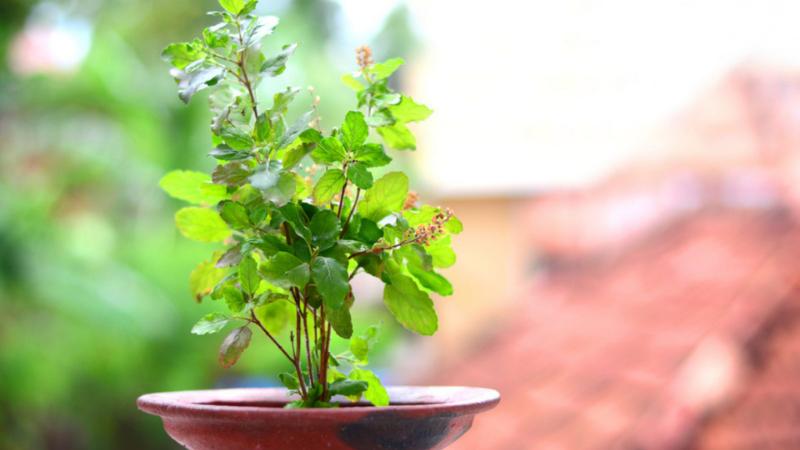
It’s the most common form of growing Tulsi. Basil is frequently a late bloomer. These seeds germinate quickly, but the plant grows slowly for several weeks. As a result, people become concerned that something is wrong with the process of how to grow tulsi plant from seeds because it hasn’t grown much in a few weeks.
Your holy basil will most likely sit there with only one small set of leaves for several weeks. Don’t worry as long as the leaves are green and healthy. Your plant will soon begin to overgrow and help you to know how to grow tulsi from seeds in winter.
Talking about how to grow tulsi plant from seeds, the following are the steps you need to follow-
Process 1 – Propagation
Taking a cutting from a healthy mother plant is the simplest way to propagate a tulsi plant.
In the spring and summer, take cuttings that are a few inches long and have a couple of leaves. Plant the cutting in a small, moist pot, fresh potting soil. Some people like to soak the cut ends in a rooting hormone before reaching the next steps of how to grow tulsi plants from seeds, but this isn’t necessary.


Place the pot in a warm, light location that is not in direct sunlight. In fact, if you are dedicated, then a kitchen work surface is an excellent choice. Water the cuttings on a regular basis to keep the soil moist, and you should see new shoots in 4 to 6 weeks.
Step 1 – Start The Process Indoors
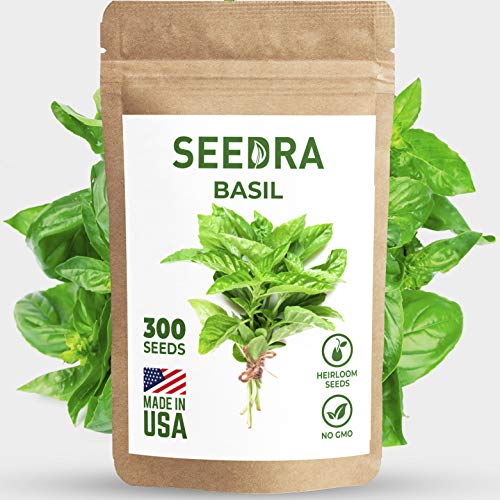

Though you are planning how to grow tulsi plants from seeds, it’s better if you start the process indoors. Then, you can easily just place it outdoors with insufficient sunlight.
Step 2 – Fill a Flowerpot With Soil
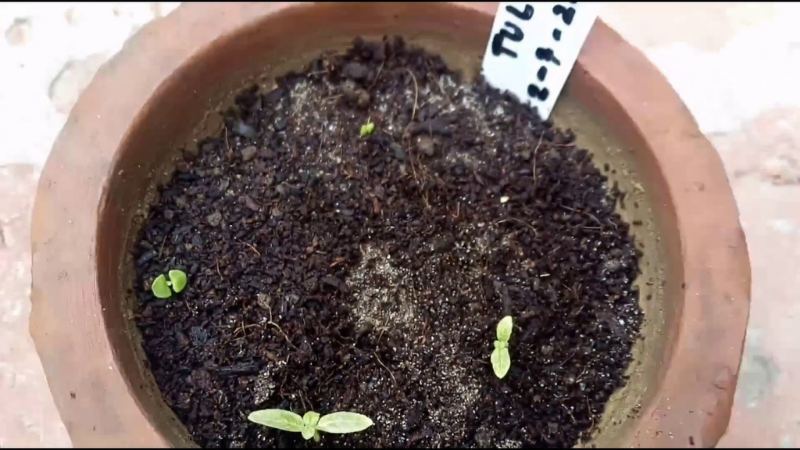
First, you need to fill a flowerpot with high-quality soil, and you should water it precisely. Also, apply a significant amount of water to wet the soil, but be careful not to overdo it and make it soggy. Otherwise, you will still be confused about how to grow tulsi plants outdoor!
Step 3 – Prepare The Stem/Seed
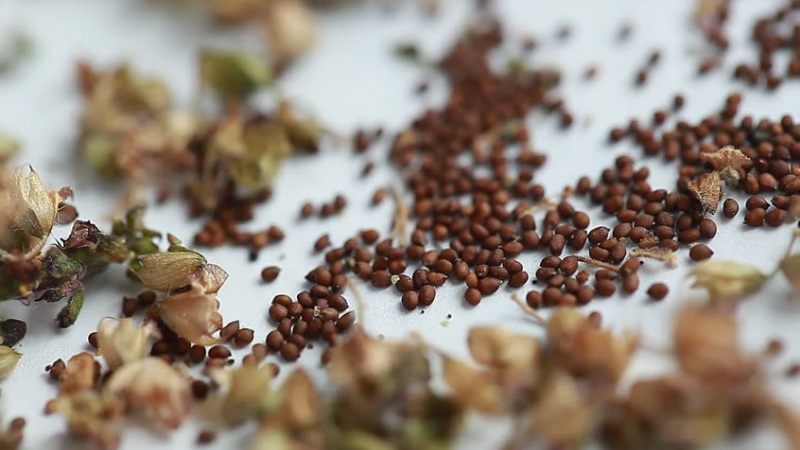
Cut a portion of a 4-6 inch stem from a mature tulsi plant. Then remove the stem just below a set of leaves and discard it. Remove all of the remaining leaves from the bottom of your cutting. About 2 inches (5.1 cm) of the stem should be left entirely naked.


Be careful to choose a stem that hasn’t flowered yet while cutting the stem. You can take a cutting from a flowering stem, but it will be more difficult to root, and the plant will have a harder time surviving. To speed up the process, dip the cut end into a rooting hormone. Rooting hormones are available at local nurseries and gardening supply shops.
Step 4 – Sow The Seed
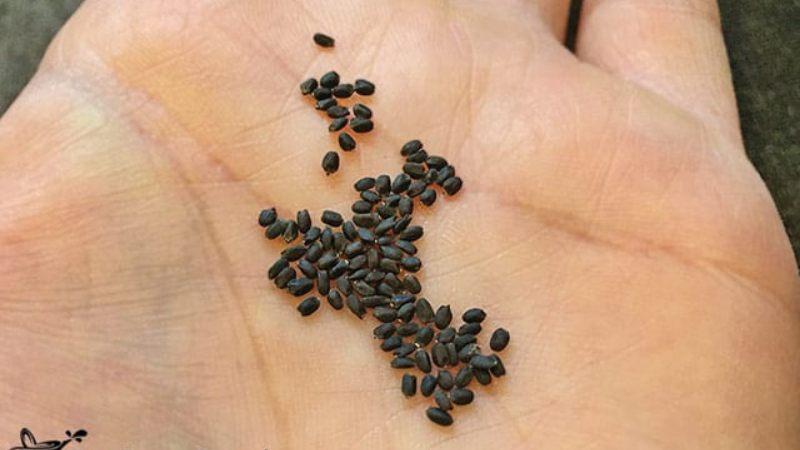
You need to sow the seeds at a depth of 1/4 inch below the soil. Soak the tulsi seeds in water and firmly push them into the ground. If you’re planting seeds in pots or seed trays, make sure you use excellent all-purpose compost. Then just slowly tap the seeds onto the soil gently. You can either use your fingers or any other shovel-like things.
Step 5 – Wait For The Germination
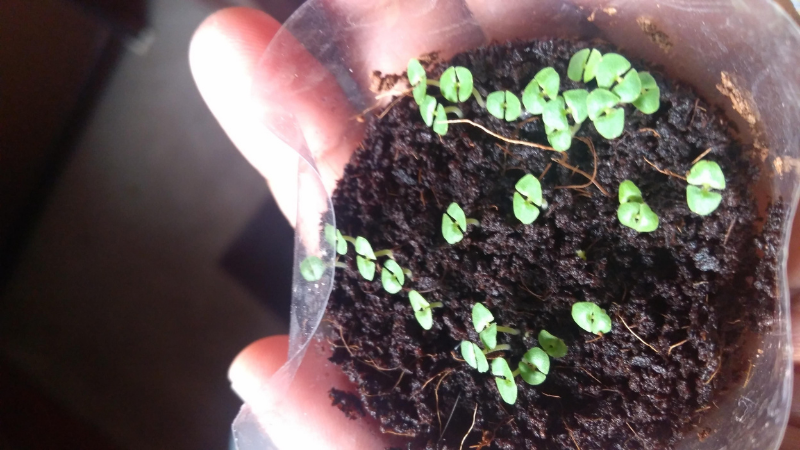
It’s a must to keep the soil moist until the germination of the seeds does not happen. After some days, mostly 7 to 10 days, you will see the change known to be germination that will ensure you the steps of how to grow tulsi from seeds in winter as well. In this phase, the seeds tend to remain very sensitive. So, you can use spray-on it two times a day to ensure proper care of your plant.
Step 6 – Wrap it Up
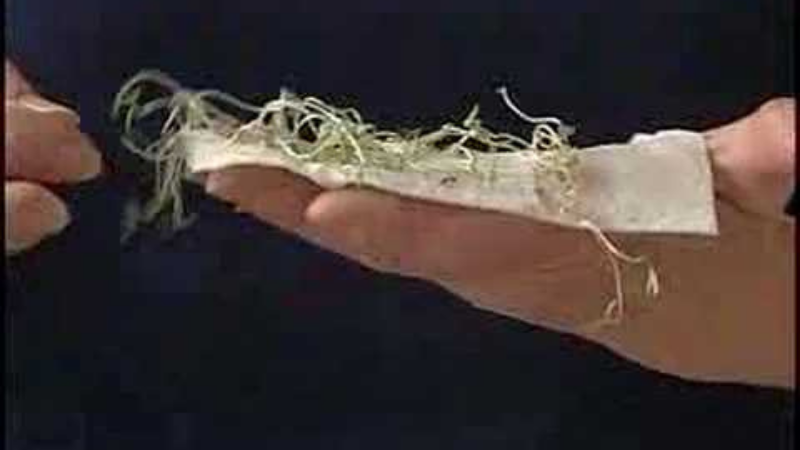
To ensure the moisture inside, you can also wrap it with plastic paper. Place your tulsi plant in a bright, warm location. Select a windowsill or table where the plant will receive at least 6-8 hours of bright, warm sunshine.
In warm temperatures, holy basil germinates in 7-14 days. During this time, keep the soil damp but not soggy. When sprouts appear, place the trays under grow lights or near a bright window.
Please cover it from the sides with a wafer-thin mesh cloth during the winter to protect it from the harsh winters; otherwise, it may die.
If necessary, spray a neem-based solution to repel insects.
Process 2 – Repotting
When the seedlings are large enough, you can transplant them into individual pots.
If you intend to grow your holy basil in pots, you will need to report the plants on a regular basis. While some people prefer to repot theirs every spring, others prefer to leave the plant in its container until it outgrows. Check if it becomes bound in the pot.
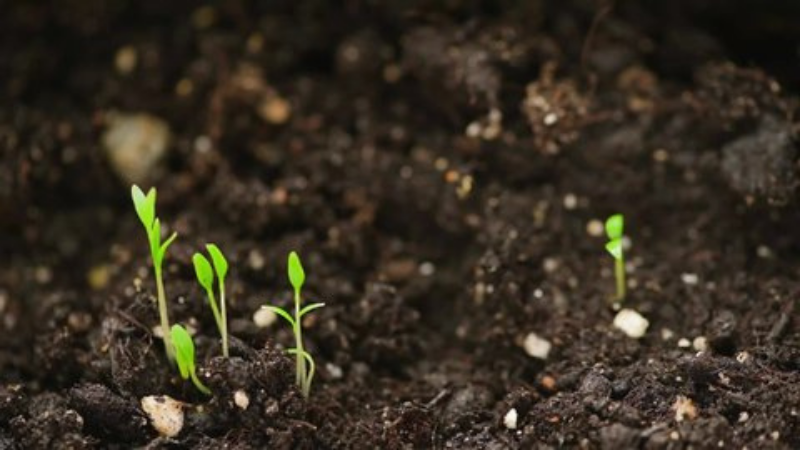
Make sure to take the plant out of its old pot or seed tray. If the roots of more established plants become tightly bound together in a “root ball,” gently tease them free.
After that, fill the pot with fresh potting soil or all-purpose compost. When you put the plant inside, the top of its roots should be just below the pot’s lip. Add more compost or potting mix after you’ve placed your tulsi plant in the center of the pot. Don’t overdo it to the point where the soil becomes compacted. Allow some space at the top of the pot for watering.
After planting, water the plant and place it back in its original location.
Requirements for Tulsi Germination
- A minimum temperature of 21 degrees celsius is perfect for a Tulsi plant.
- Seeds that are tiny, dark black, or brown. Each seed is no more than 0.3-0.5 mm in size.
- The time frame is from spring to summer.
- Above 50 degrees Fahrenheit (22 degrees Celsius).
- Soil is well-drained and rich in nutrients.
- Sprinkle the seeds on top of the growing media.
- 4 to 6 hours of direct sunlight is recommended. Grow light should be on for 12-16 hours if you need to understand how to grow tulsi from seeds in winter.
- Watering is required on a regular basis. Keep the soil moist at all times. If you overwater the plant, it will not die.
- Tulsi plants can withstand extreme heat, but even a light frost can kill them. In colder climates, these plants are grown as annuals. Perennial Tulsi Plantation thrives in US Hardiness Zones 10 and above.
How to Grow Tulsi Plant from Cuttings?
It takes a lot of time to grow plants from seeds. So, knowing the process of how to grow tulsi plants from cuttings is a good substitute. Growing basil from cuttings decreases the time it takes to grow basil in half. It takes 2 to 3 weeks for the roots to emerge, but once they do, the plants immediately put out new growth that may be harvested. Plus, basil can be grown from cuttings all year!
Basil can be rooted in two ways: in water or in potting soil. You’ll need basil cuttings for each procedure. To achieve your goal of how to grow tulsi plant outdoor, some steps are given below in order to provide you with proper instructions-
Step 1 – Take a Healthy Clipping

Take a healthy green clipping from the Tulsi plant and use it to make tea. At least 4-6 inches long and green in color, the cutting should be used. Stiff stems can be utilized as well, but they will take longer. Both have their benefits and drawbacks.
Step 2 – Clean it Up
Remove any blooms or seeds that may have landed on the cutting. Remove a few of the leaves towards the bottom of the plant while going through the process of how to grow the tulsi plant from cuttings.
Clean the cuttings by dipping them in water. Use only 2-3 inches of water. It should suffice for adequate hydration.
Step 3 – Keep It Close To The Window
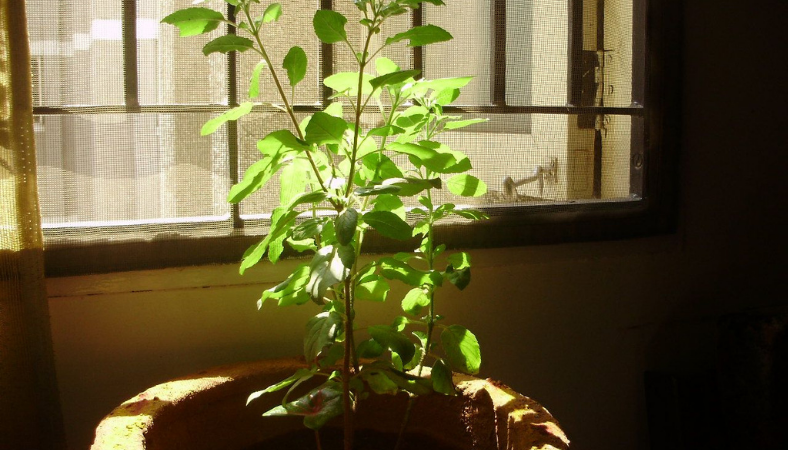
Keep this cutting near a window sill with plenty of light. Root germination requires at least 4-6 hours of indirect light.
To avoid stagnation, change the water every 4-6 days.
Even if you do everything correctly, your chances of success are only 20-30%. To put it another way, you may only obtain 2 or 3 well-rooted cuttings if you clearly know how to grow tulsi plants from cuttings.
Once the root system is strong enough to support the plant, you can transplant the cuttings to the soil.
How to Grow Tulsi from Leaves?
Step 1 – Set A Section
Tulsi or basil can be grown in pots or in the ground from its leaves if you actually know how to grow tulsi from leaves. It will grow faster in pots because the soil warms up more quickly. However, if you want a large basil harvest, you should probably set aside a section of your garden to plant.
Step 2 – Ensure Proper Sunlight

Plant your basil in full sun, which means at least 6 hours of sunlight per day- it’s the most important part of how to grow tulsi from leaves.
Step 3 – Ensure Proper Drainage
Tulsi basil does not like standing water, so make sure your soil drains well before applying the steps of how to grow tulsi from leaves. If you’re going to use containers, look for ones that have drainage holes in the bottom or drill your own.
Step 4 – Amend The Soil With Compost
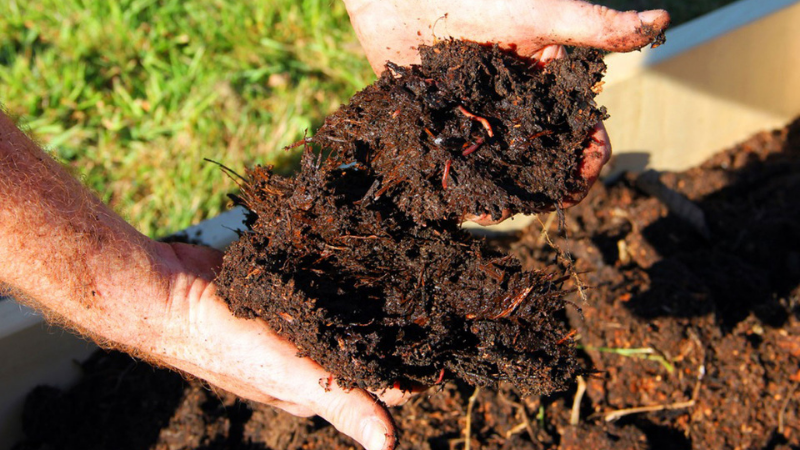
Before planting, amend your soil with compost, well-rotted manure, or another type of organic material to keep your plants fed and happy.
Basil needs much heavier fertilizer than most herbs, so it does benefit from fertilizing on a regular basis.
Tulsi should not be planted until the last frost has passed.


How to Plant out The Tulsi Plant Perfectly?
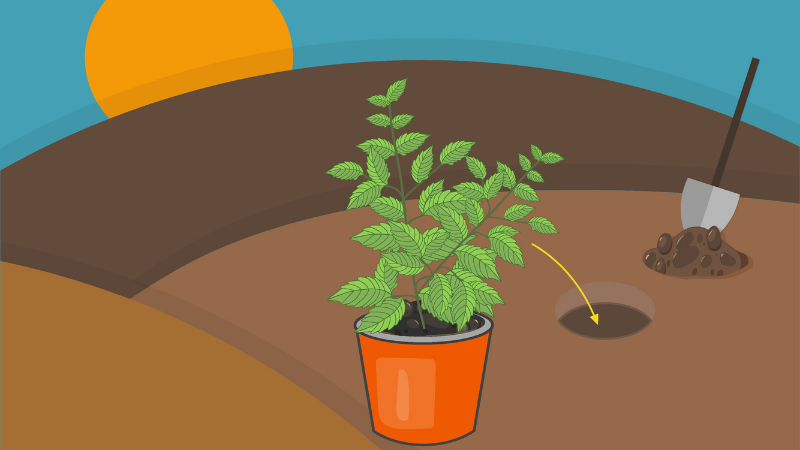
If the plants are to be planted directly into the ground or in outdoor pots, they must first be hardened. This will assist them in acclimating to their new surroundings. When growing in the background, keep in mind that all basils prefer fertile soil.
Before planting, thoroughly dig the soil to allow air to circulate through it. Air circulation can also be improved by digging well-rotted organic compost or manure into the soil about a month before planting.


Make a hole slightly larger and deeper than the pot it is currently in during the process of how to grow tulsi plant outdoor. Brush away any soil from the roots gently, taking care not to damage the root system.
Place the plant in the gap so that the root tops are just below the soil level. Fill the void with high-quality, all-purpose compost. Water thoroughly. If you intend to plant more than one plant, give a space of 18 inches between them.
Why Does The Tulsi Plant Die in Winter?
If there is more water in the soil and atmosphere than the plant requires, it will die over time, but it can still regenerate.
In winter, most of the plant owners make the mistake of overwatering tulsi plants. As we know, winter is the exact season when the plants are already drenched in natural water. So, they don’t need to be soaked in water regularly, and if you do so, the soil would be extra soggy for them to absorb water and ultimately die.
On the other hand, we always tend to ignore fertilizers because plants will naturally get essential composts. But in reality, it’s a must to maintain fertilizer no matter what the season is. Then the lack of enough sources to get sunlight creates a big difference in winter. Combining all these, this specific season can be called a life hunter to the plants, indeed. But if you take the necessary steps to fight, it can be rejuvenated as well!
Read More – Why Does The Tulsi Plant Die in Winter?
Which Soil is Best for a Tulsi Plant?
Yes, Tulsi needs direct sunlight of at least 5 to 8 hours regularly.
Tulsi is a delicate plant, but it does possess some sensitive issues. It can die in extra soggy weather, as well as suffer in less moist ambiance. It also gets dry quicker if you don’t take care of it humbly and know how to grow tulsi plants outdoor.


But one crucial element that necessitates in every sphere of Tulsi growth is- sunlight. It is a lover of sunlight and is proven to grow faster under direct sunlight. But according to the experts, it’s better to place your plant- tub near a window or open surface. It helps your plant to get a warm feeling of the sun during the day.
Tulsi Basil Harvesting Instructions
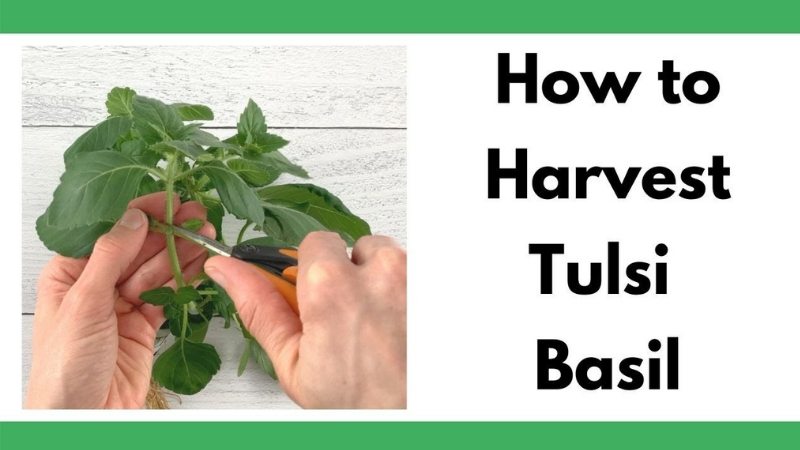
Step 1 – Harvesting Small Amounts of Basil
You can begin harvesting small amounts of basil as soon as the plants reach 6-8″ in height to know how to grow tulsi from seeds in winter. To prune and harvest your plants at the same time, pinch back the growing tips with one or two sets of leaves.
Step 2 – Wait Until The Plants are Tall
Wait until the plants are about a foot tall and bushed out for a larger harvest. The herb thrives on regular small to medium-sized harvests, but you can harvest up to half of the leaves at any time.
Step 3 – Make it Dry and Stored
Tulsi leaves, like any other type of basil, can be dried and stored if you want to ensure how to grow tulsi from seeds in winter. Harvest entire branches rather than individual leaves to dry. If it’s the time of the last harvest of the season, and you don’t know how to grow tulsi plants outdoor, cut the units at the stem level.
Step 4 – Bing The Branches Together
Bind the branches together and hang them in a warm room to dry. Remove the dried leaves from the stems and store them in an airtight container or sealable bag.
Step 5 – Clean Pair of Garden Snips
Remember to use a clean pair of garden snips or sharp scissors to harvest basil stems. Snip off the desired stem length, just above a node (where you can see a small set of new leaves). These fresh, tiny leaves will grow into new stems, making your plant sturdy and bushy rather than long and spindly.
When Should Basil be Planted?
Basil seedlings can be planted outside a few weeks after the last frost date in the spring. But don’t rush it because basil is extremely sensitive to cold temperatures!
Wait until nighttime temperatures do not fall below 50°F and the soil has warmed to at least 50°F. Because your holy basil plants won’t grow much without heat, it’s important to be patient before planting and follow the exact steps of how to grow tulsi plants outdoor.
You Need Fertile Soil


Tulsi grows best in loamy or fertile soil. For healthy plants, good drainage is essential, and soil with a pH of 6 to 7.5 is ideal.
Spread a fertile soil named coarse mason sand to a depth of 2 inches around your seedlings when they are 3 inches tall. This sand mulch controls moisture, reduces weeds, and moderates temperature fluctuations.
Ensure Proper Watering

Your tulsi plant will need to be watered regularly. When in doubt, wait until the top inch of soil feels dry to the touch. During the winter months, when it’s common for the plants to grow slowly, they require less water.
Avoid getting water on the leaves because damp leaves are a breeding ground for mold and disease. This may become more difficult as the plant grows bushier. Watering early in the morning, I’ve discovered, gives the leaves time to dry off in the sun before the temperatures drop.
Maintain Temperature and Position
Tulsi grows best in full sun and prefers 4 to 6 hours of sunlight per day. However, it can grow in partial shade.
As previously stated, these plants are hardy to zones 10 or 11, depending on the variety. This herb grows best in areas where temperatures rarely fall below 50 degrees Fahrenheit. Tulsi can be grown outside all year in areas where there is no frost. You can also grow it outside in the summer and bring it inside when the temperature drops. Tulsi can be grown as a year-round house plant because it is not a large plant.
Provide Food


You’ll need to feed your tulsi plant on a regular basis to keep it lush and healthy. A balanced 10-10-10 fertilizer contains all of the nutrients required by the plant, but most general-purpose plant feeds will suffice.
Once every two weeks, feed your holy basil plant. When you use a liquid or water-soluble fertilizer, you can easily incorporate it into your watering routine. Every six months, replace the top two inches of soil around the plant with fresh compost. This will aid the soil’s ability to remain healthy and fertile. The appropriate times to do this are early in the spring when the growing season begins and early in the autumn when the plant goes dormant.
The Most Common Tulsi Plant Issues and How to Solve them?
These are generally simple plants to grow, but they can occasionally succumb to disease or infestation. Early detection of disease or infestation means that it can be easily treated.
Pests Control


Pests Typically, pests attack tulsi plants that are growing in poor or unsuitable conditions. If your plant is frequently attacked, think about relocating it. Aphids, mealybugs, spider mites, and whiteflies have all been observed feeding on holy basil plants. Most infestations can be cured with an organic pesticide.
Many people believe that neem oil is an excellent alternative to using a chemical pesticide. Many infestations can be cured by a simple solution of dishwashing detergent mixed with warm water and applied to the leaves.
Don’t be concerned if you have to repeat the treatment several times before completely ridding the plant of the infestation; this is quite common. When applying, make sure to cover both sides of the leaf in order to get a good result on the system of how to grow tulsi plant outdoor.
Read More – Best Insecticide For Indoor Plants
Leaves that are discolored or wilting
This could indicate that your plant isn’t getting enough light. This can be alleviated by simply changing locations.
Or you can use artificial lighting. Find the best-led light for the tulsi plant and use it.

No products found.
It could also indicate a sign of overwatering. If you are concerned about this, stop watering for a couple of weeks or until the soil is dry enough to work on.
Unless you live in a climate that keeps you warm, your tulsi will require winter protection. Cover it properly with a cloche, plastic bucket, or tarp once the leaves have all died back. A transparent cover allows light to enter while also trapping heat and keeping the plant roots warm. In colder climates, relocate the tulsi to a greenhouse, shed, or inside your home.
In colder climates, relocate the tulsi to a greenhouse, shed, or inside your home.
Brittle Grass
This is usually a sign of a lack of light or water. Relocate your plant or slightly increase your watering. Remove any brittle leaves.
Mold
Mold can grow on tulsi leaves in moist environments. To stop its growth, wipe the leaves with a soft, clean cloth.
Weeding and Pruning


Pruning your tulsi plant on a regular basis will help you keep its size under control. When pruning, try to remove no more than half of the stem’s growth. Pinch the tops of the plants when they have four to six pairs of leaves. This will ensure your plant grows bushy rather than weak and leggy. And always remember to know the proper way of how to grow tulsi plants outdoor.
You should also remove flower buds as soon as they appear. By preventing flowering and seed production in this manner, the plant is encouraged to grow more lush and full.
Finally, to encourage new foliage growth, remove any wilted or discolored leaves.
Remember these things before Planting a Basil Plant
Because the Tulsi plant has miraculous properties, it is grown at home. Tulsi removes Vastu defects by dissipating the negative energy of the house. This plant contains both medicinal and divine properties.
Planting Tulsi plants provides health and religious benefits, ensuring that your body and mind are always in good health. Basil can help protect against various serious diseases, including the common cold, cough, etc.
Vastu defects are removed, and negative energy is destroyed by planting the Tulsi plant in the house. In this way, when using Tulsi at home, these special considerations must be kept in mind; only then will positive results be obtained. Keep these points in mind when using basil.
- According to religious belief, the Tulsi plant should be planted on Thursday, and it is best to plant it in Kartik month.
- It is thought to be essential to plant Tulsi in the middle of the house or the courtyard; otherwise, applying it in the opposite location will not yield positive results.
- Basil should not be planted in a dirty area of the house, and its leaves should be plucked first thing in the morning.
- Because the leaves of this plant do not rot after being broken, they can be kept in worship for several days and repeated and offered to the gods.
Related Article
How To Grow Tulsi Plant Indoor?
Last update on 2023-01-28 / Affiliate links / Images from Amazon Product Advertising API
 |
 |
 |
 |

About Lee Safin
Lee Safin was born near Sacramento, California on a prune growing farm. His parents were immigrants from Russia who had fled the Bolshevik Revolution. They were determined to give their children a better life than they had known. Education was the key for Lee and his siblings, so they could make their own way in the world. Lee attended five universities, where he studied plant sciences and soil technologies. He also has many years of experience in the U.S. Department of Agriculture as a commercial fertilizer formulator.
Thoughts on "How To Grow Tulsi Plants Outdoors | The Ultimate Guide To Grow Basil"
 |
 |
 |
 |
Get FREE Gardening Gifts now. Or latest free toolsets from our best collections.
Disable Ad block to get all the secrets. Once done, hit any button below
 |
 |
 |
 |